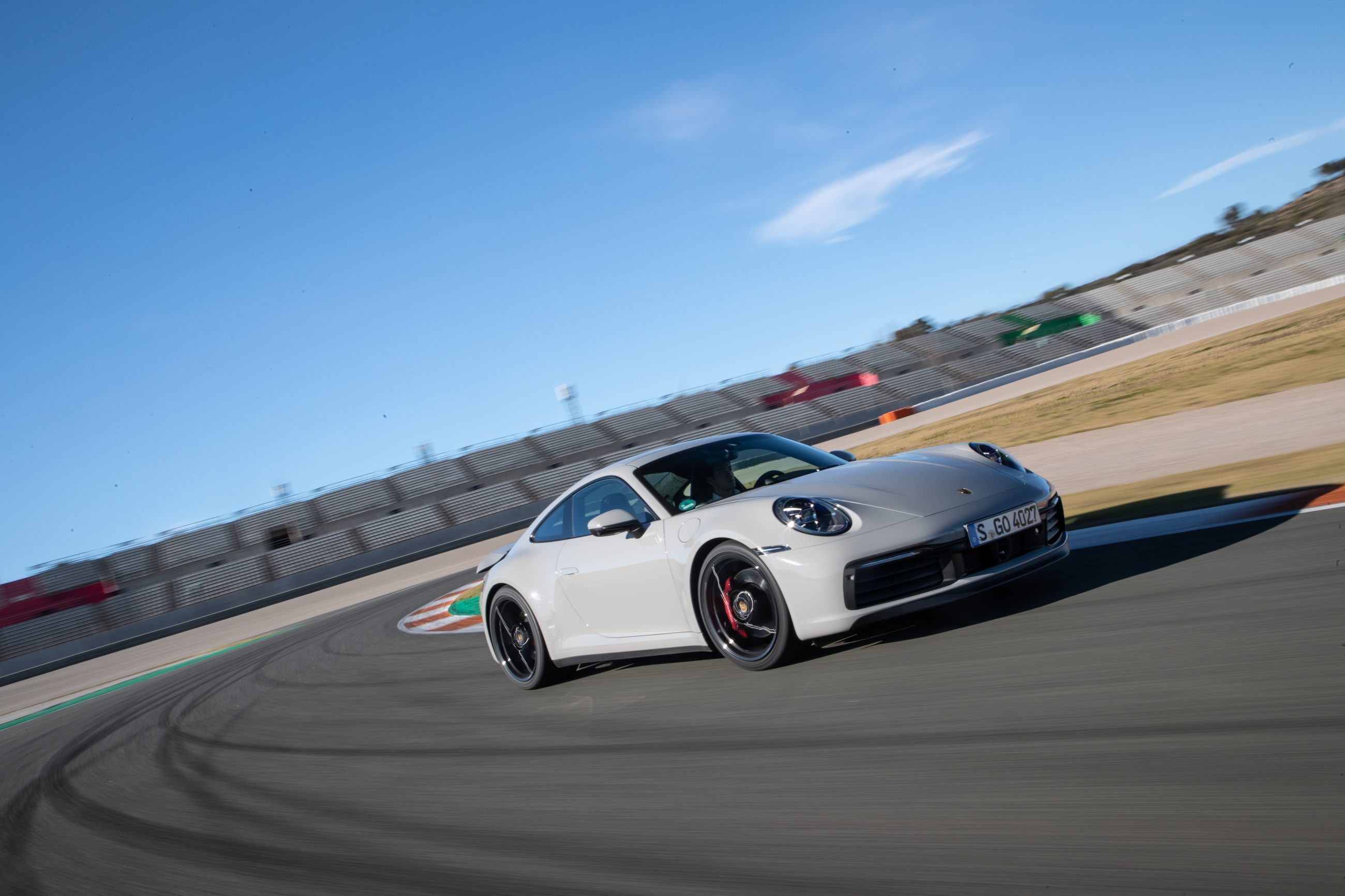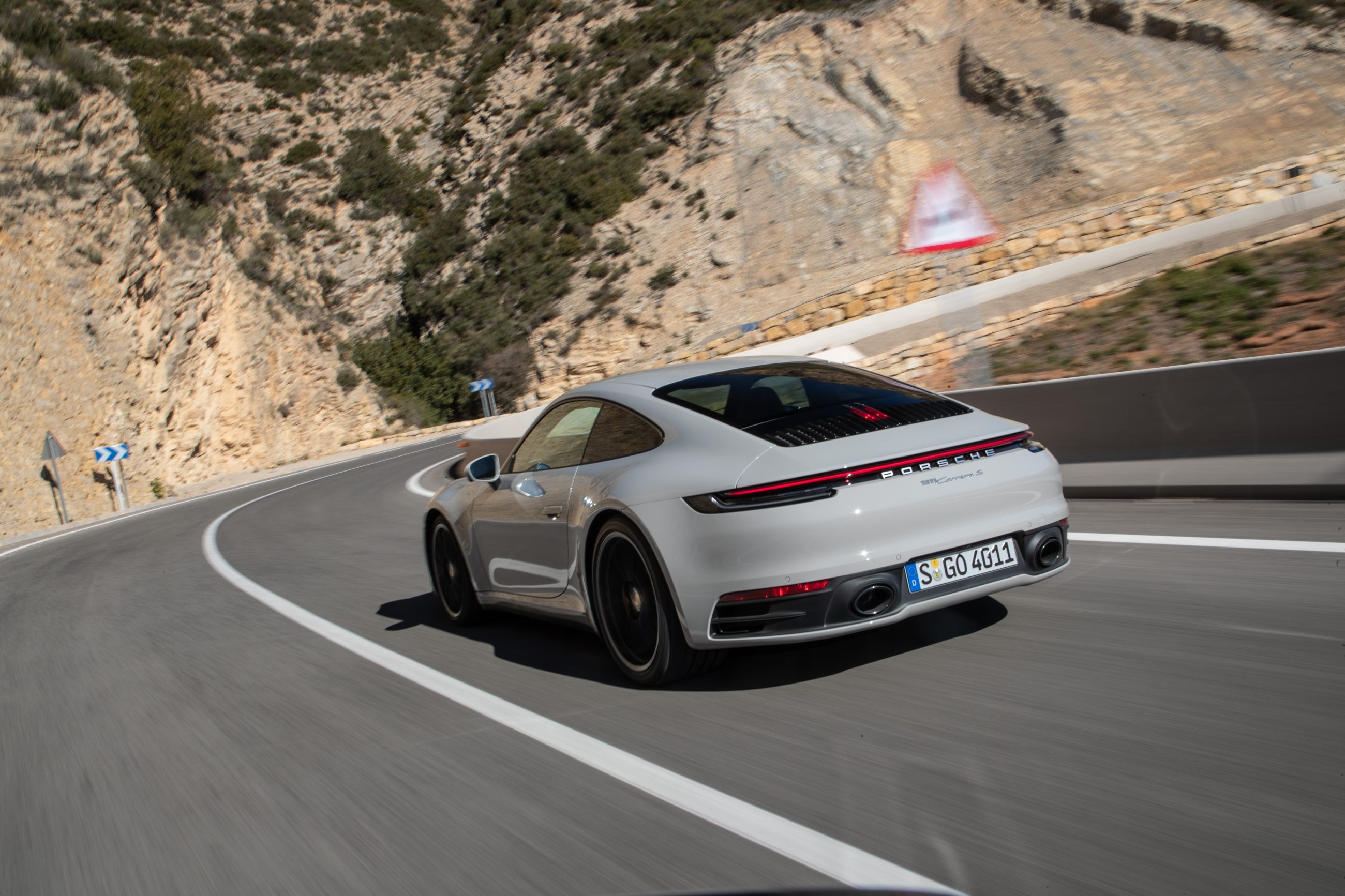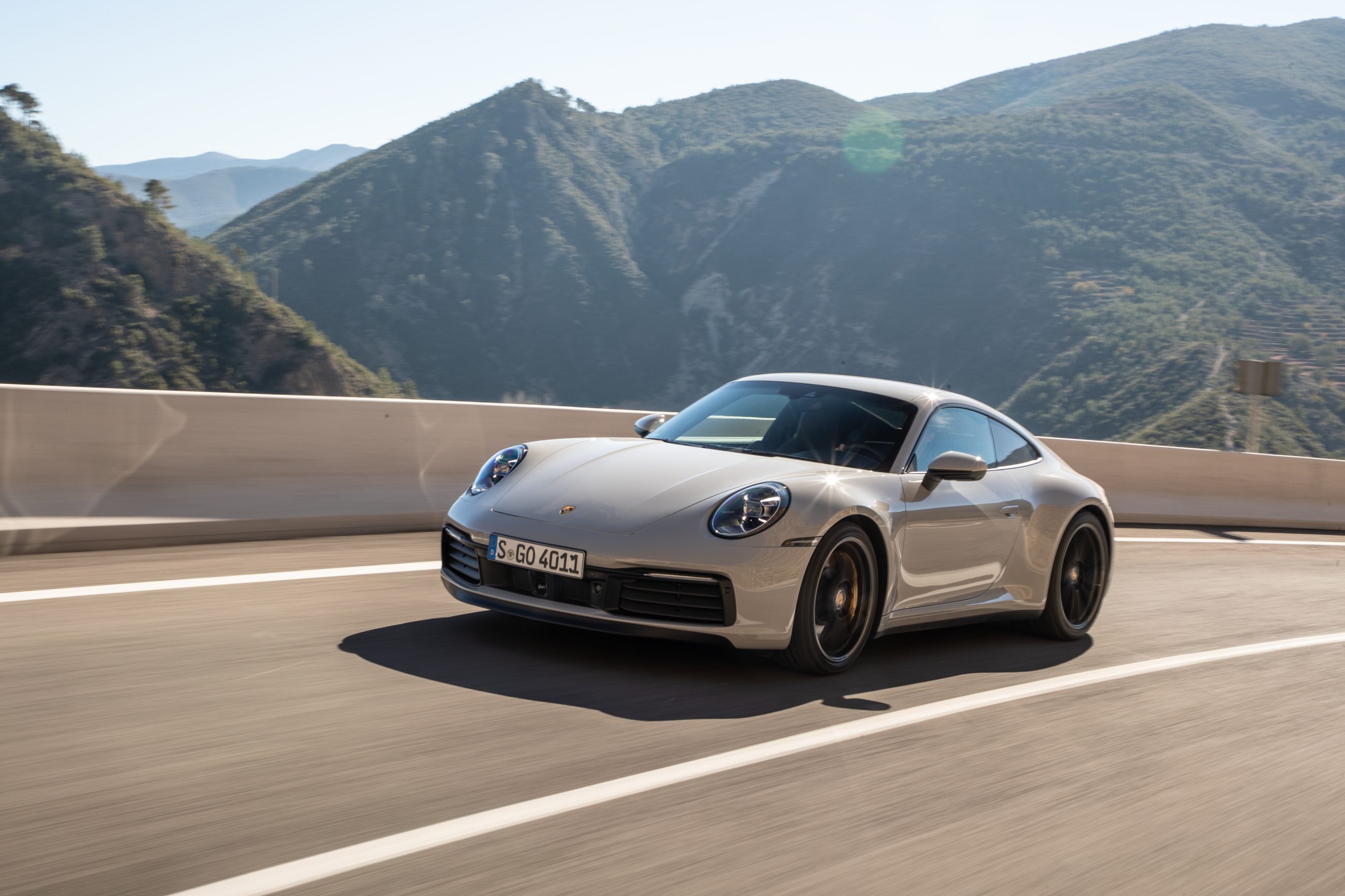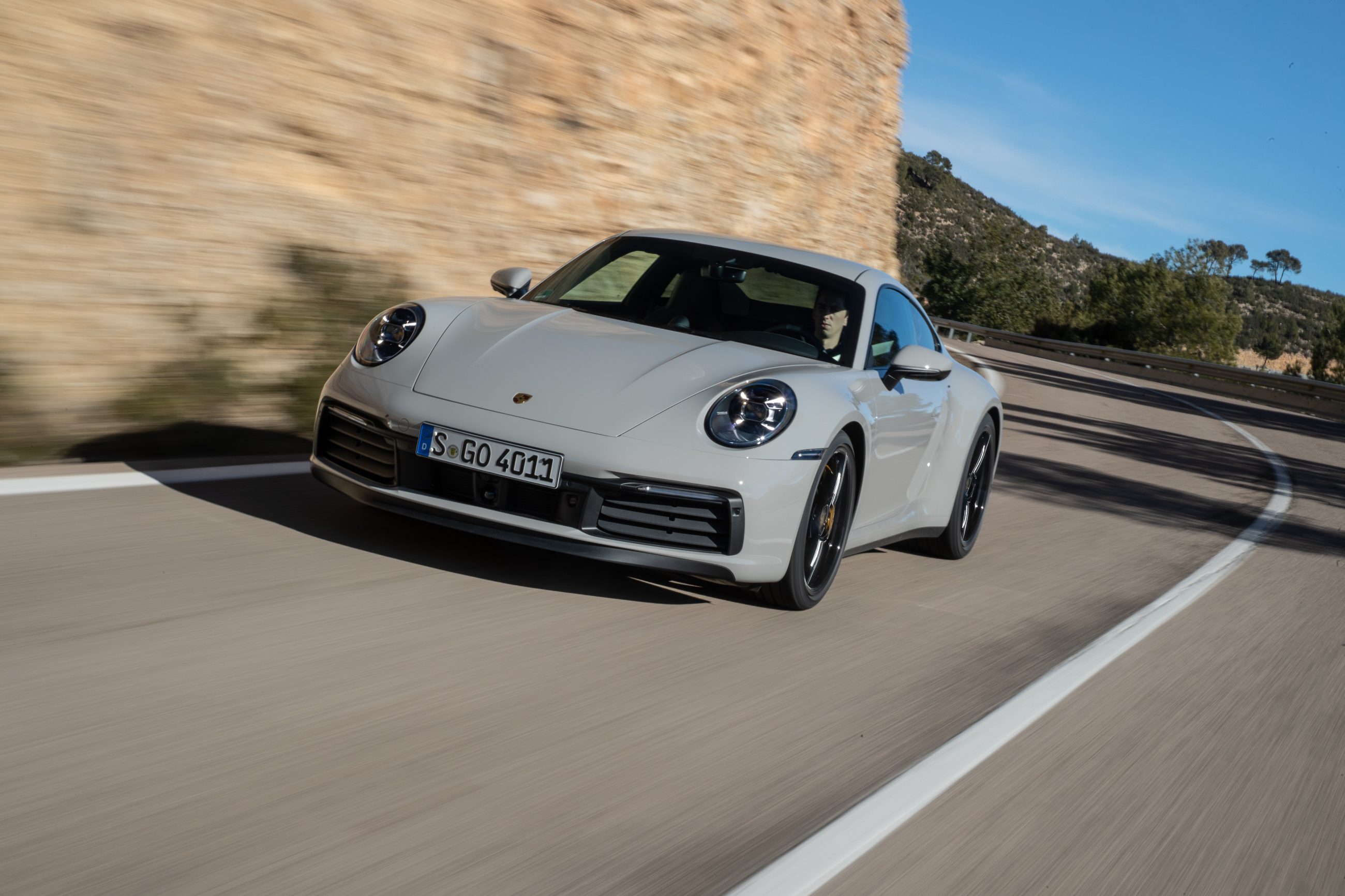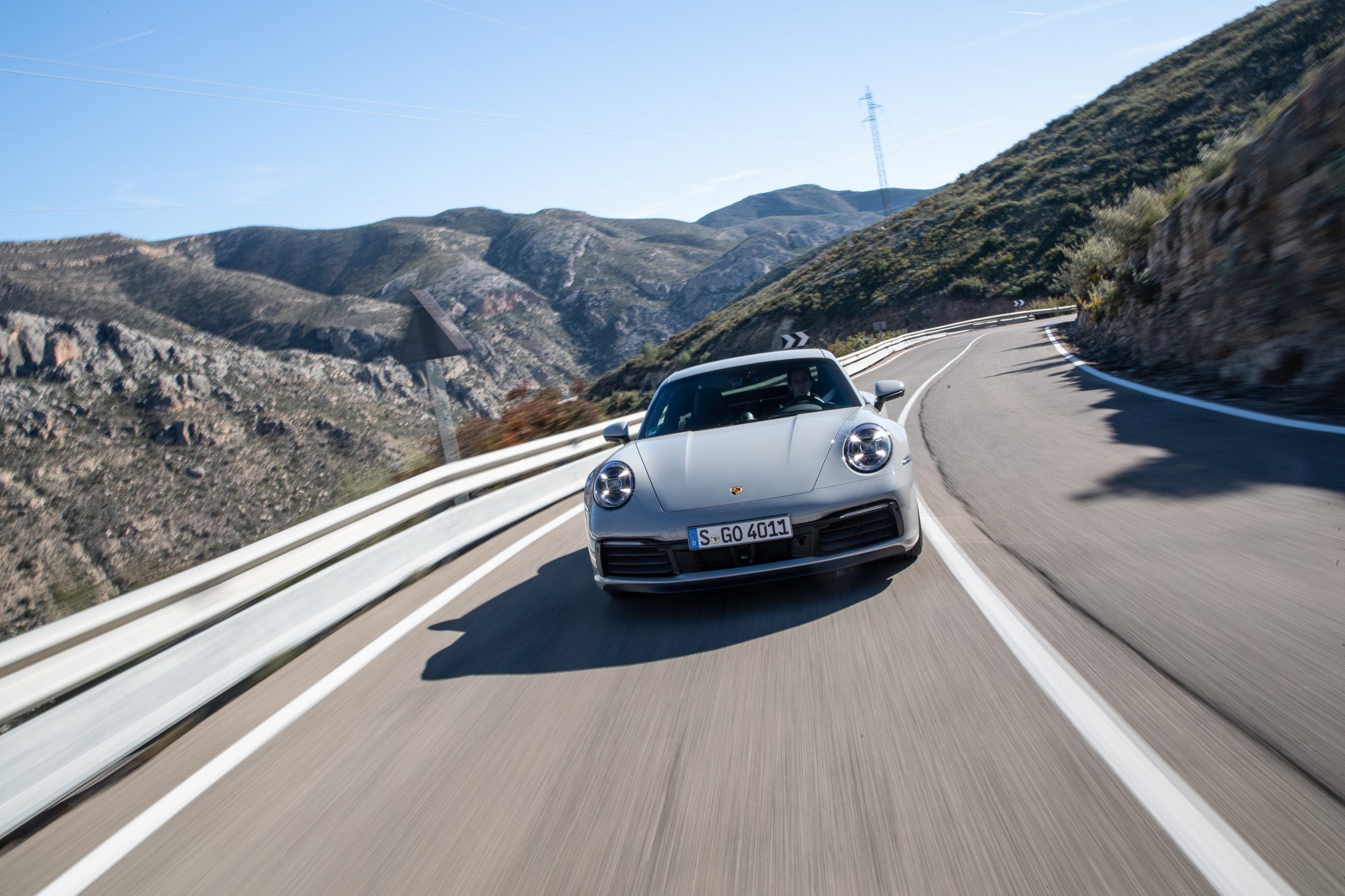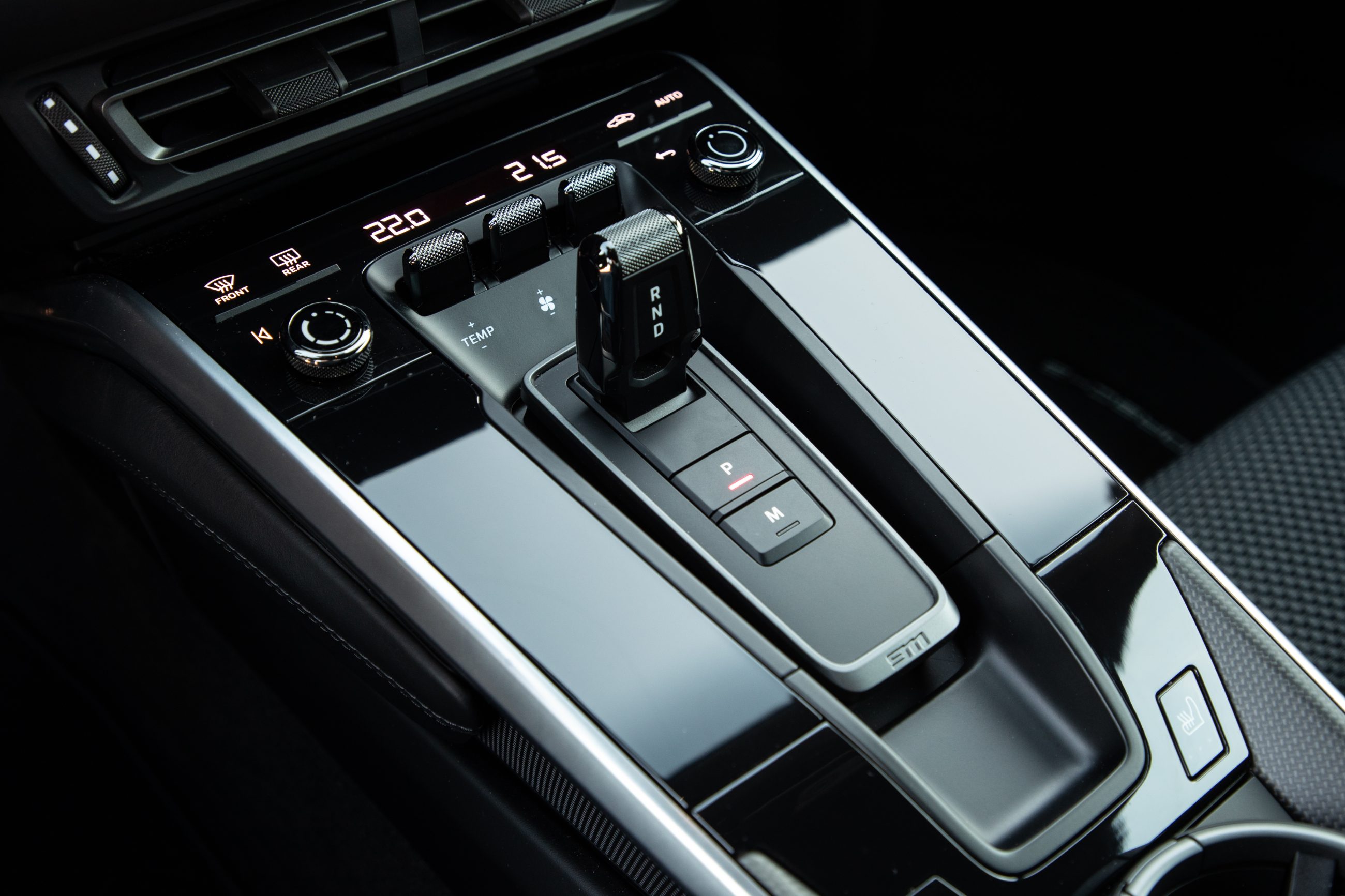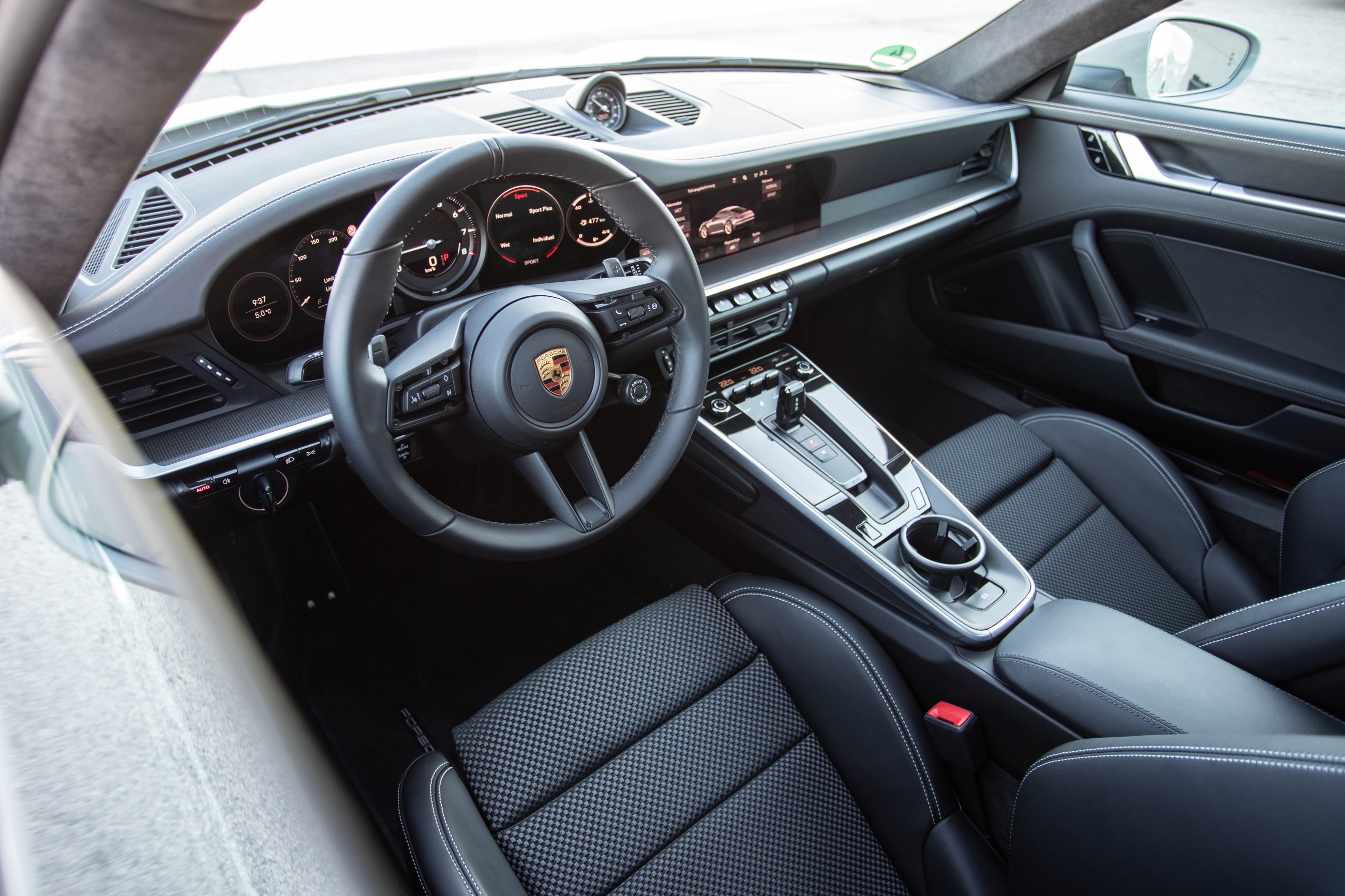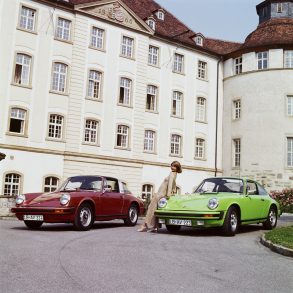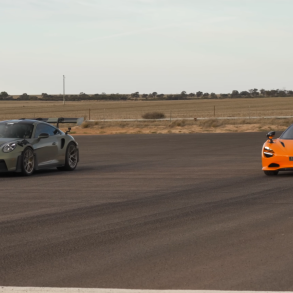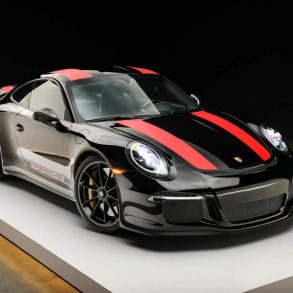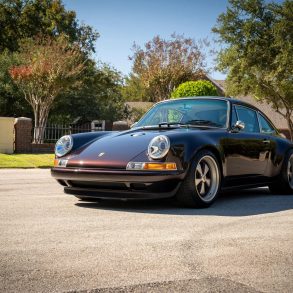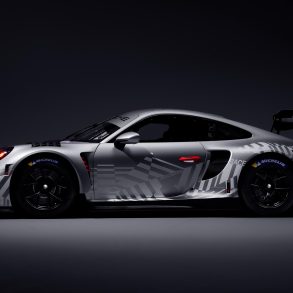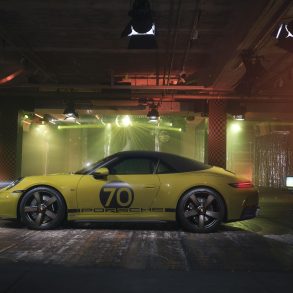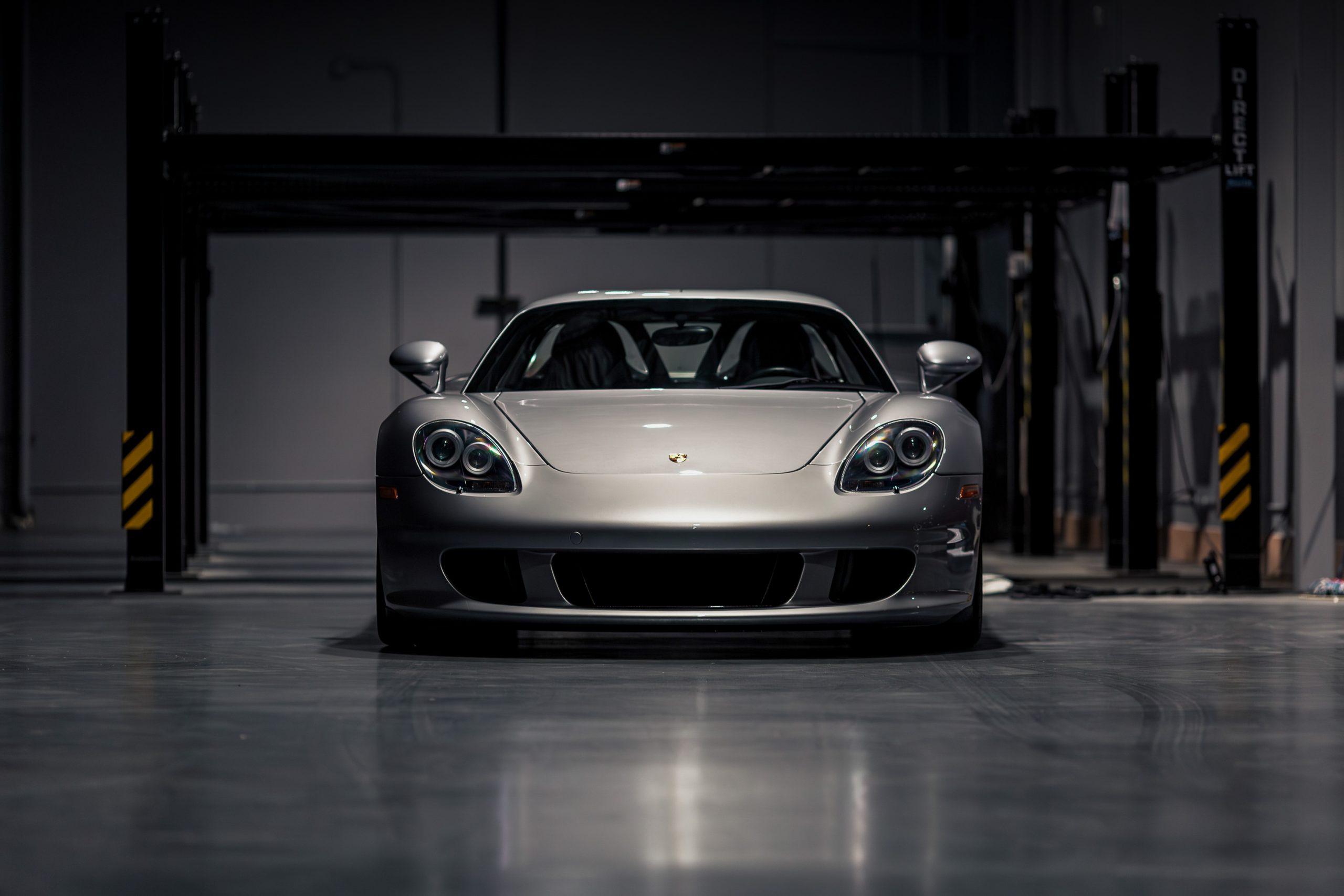2019 – 2024 Porsche 911 (992.1) Carrera S Coupe – Reviews, Pricing, Specs & Buyers Guide
The 992-generation Porsche 911 Carrera S Coupe is the car that reset the “sweet spot” for modern 911s. Launched for 2019, it arrived with more power, a stiffer and wider platform, new driver-assistance tech like Wet Mode, and a new 8-speed PDK—then, crucially, welcomed back a 7-speed manual option for 2020. Between 2019 and the close of the 992.1 era (2024), the S delivered supercar-level pace with everyday polish, making it the default recommendation for buyers who want a single 911 to do it all. This guide covers the story, specs, tech, how it drives, what changed year-to-year, options that matter, market/pricing context, and what reviewers said.
Origins & Positioning
Porsche unveiled the 992 at the 2018 LA Auto Show. From the outset, the Carrera S sat as the performance step above the base Carrera, packing a 3.0-liter twin-turbo flat-six tuned to 443 hp (331 kW) and 390 lb-ft, with a top speed quoted at 308 km/h (191 mph) for the RWD S. Beyond the headline power bump over 991.2, the 992 introduced structural and tech changes: wider tracks and wheel housings, flush door handles, a redesigned interior with a larger center display, and the debut of Porsche Wet Mode to enhance stability on soaked roads. At launch, the S shipped exclusively with the 8-speed PDK. Porsche then answered purist prayers: beginning with the 2020 model year, a 7-speed manual gearbox became a no-cost option on Carrera S and 4S coupes and cabriolets (paired with Sport Chrono), with U.S. deliveries starting spring 2020. That move cemented the S as the most configurable driver’s 911 in the lineup.
Powertrain, Driveline & Chassis
- Engine: 3.0-liter, twin-turbo, DOHC, direct-injected flat-six
- Output: 443 hp @ 6,500 rpm; 390 lb-ft (broad plateau)
- Redline: 7,500 rpm
- Transmissions: 8-speed PDK dual-clutch (standard at launch; tightly stacked lower gears, long 8th for cruising), 7-speed manual (from MY2020, no-cost, bundled with Sport Chrono, rev-matching and dynamic engine mounts)
- Chassis: MacPherson-strut front, multi-link rear; optional rear-axle steering; available PASM and PASM Sport (-10 mm). Brakes start with 350/350-ish mm-class steel rotors depending on configuration; PCCB ceramics (410/390 mm) optional. Staggered wheels/tires are standard; most S coupes ran 245/35ZR20 front and 305/30ZR21 rear (varies by market/wheel choice). Porsche’s US data sheet for 2020 S/4S lists curb weights around 3,382 lb (PDK, RWD S) and 3,298 lb (manual S), underscoring that three-pedal spec saves a few dozen pounds. Top track speed appears as 191 mph (PDK S).
- Aero & Body: Wider body than a base 991, adaptive cooling flaps, and a multi-position rear spoiler integrate with drive modes. The overall drag area and stability targets were tuned for high-speed confidence with minimal lift. The wider rear track/wheel housings not only enhance stance but also traction, particularly out of tight corners.
Performance: Paper vs. Reality
Factory claims (PDK, early 992.1): 0–60 mph in the low-to-mid-3s with Sport Chrono and 191 mph top speed (RWD S). Independent testing showed the S to be even quicker. Car and Driver (PDK) launched it from 0–60 in 3.0 seconds and did the ¼-mile in 11.3 seconds @ 125 mph. In some tests they recorded 2.9–3.0 s 0–60s with launch control. MotorWeek instrumented a PDK S at 3.0 s to 60 and 11.3 @ 124 mph. Car and Driver (7-MT) noted the manual’s slower launches, but praised its involvement; they measured an 11.8-second quarter in the manual S and highlighted how the car pulls hard past 150 mph. The real-world takeaway is that with PDK, the S is violently quick; with the manual, it’s a richly tactile road car that’s still seriously fast.
Signature Tech: Wet Mode & PCM
Wet Mode debuted on the 992 and is standard across the family. Acoustic sensors in the front wheel housings “listen” for spray and, when water is detected, preconditions PSM/PTM interventions and recommends Wet mode; aero and PTV+ behavior also adjust for stability. It’s not a gimmick—several early reviews remarked on the 992’s calmness on soaked pavement.
Infotainment (PCM 6.0). Mid-cycle, Porsche rolled out a software update (January 2022) for PCM 6.0 that added functions including Android Auto and a refreshed UI (alongside existing CarPlay). If you care about smartphone integration, 2022-on cars are desirable; earlier cars won’t generally retrofit to full PCM 6.0 parity.
How It Drives
The S’s personality splits by gearbox but shares the same core virtues: steering linearity, outstanding traction, and immense mid-range urge.
-
PDK S: The car feels telepathic on a back road and devastatingly effective out of tight corners. Car and Driver’s early PDK test emphasized just how ferocious the launches are, with consistent 3.0-second 0–60s and the feeling that the 992 puts its power down better than ever.
-
Manual S: The seven-speed shifter is light but precise, with a long throw into 7th that takes a beat to learn. C/D called it a “totem of mechanical rightness,” and for many owners, it’s the spec that transforms the S from merely rapid to memorably involving. Expect ~4.0-sec 0–60 “around four seconds” in Porsche’s own messaging for the manual.
Long-term impressions back this up: Top Gear’s team praised the 992’s traction and everyday composure, calling it “astonishing” on sketchy, greasy roads where rivals spin away torque. That confidence is a product of the platform’s stiffness, electronics tuning, and the wider rubber footprint.
Specifications (Quick Reference: 992.1 Carrera S Coupe)
- Engine: 3.0-L twin-turbo flat-six
- Output: 443 hp / 390 lb-ft
- Transmissions: 8-spd PDK or 7-spd manual (MY2020+)
- 0–60 mph: ≈3.3–3.5 s (PDK, official); ~3.0 s in testing; ~4.0 s manual
- Top speed: 191 mph (PDK S)
- Curb weight: ~3,382 lb (PDK); ~3,298 lb (manual)
- Brakes: Steel standard; PCCB optional
- Key tech: Wet Mode, PASM, optional rear-axle steering; PCM 6.0 with Android Auto (MY2022+)
Year-to-Year Highlights (2019–2024)
- 2019 (launch MY): Carrera S/4S debut with 443 hp, PDK only. Wet Mode introduced; redesigned interior/interface; wider stance and flush handles.
- 2020: 7-spd manual becomes a no-cost option on S/4S (bundled with Sport Chrono). First manual U.S. deliveries spring 2020.
- 2021: Running changes (packages and minor options) while Porsche expands the broader 992 range.
- 2022: PCM 6.0 update adds Android Auto and UI improvements (applicability by model year).
- 2023–2024: Late-cycle refinements continue; the S holds steady until the 992.2 refresh arrives for 2025-on models (outside the scope of this 2019–2024 guide).
Options & Packages That Matter
- Sport Chrono Package: Mode switch, launch control (PDK), dynamic engine mounts, and performance timers. It’s bundled by default with the 7-MT and meaningfully sharpens the PDK car.
- Rear-Axle Steering: Shrinks the car around you at low speeds; adds high-speed stability. Particularly worthwhile if you regularly tackle tight roads.
- PASM / PASM Sport (-10 mm): The standard PASM tuning is very liveable; the lower PASM Sport suits smoother roads or regular track use.
- PCCB (Ceramic Brakes): Lighter unsprung mass and superb fade resistance; for street-only use, the steels are excellent and cheaper to maintain.
- Front-Axle Lift: A sanity saver for steep driveways or urban use.
- Driver-Assist & Comfort: Adaptive cruise, lane keep, ventilated seats, heated wheel—ticks the “daily driver” box with no real performance downside.
- Wheels/Tires: The 20/21-inch stagger looks right and works well; larger visual-spec wheels can add ride harshness and tire cost without adding pace.
Reception: What Reviewers Said
- Car and Driver (PDK S): “No suspense: 0–60 in 3.0 seconds, ¼-mile 11.3 @ 125”—an object lesson in how conservative Porsche’s claims are and how cohesive the 992’s chassis feels at big speed.
- Car and Driver (Manual S): The 7-MT is “a totem of mechanical rightness”; not as quick off the line as PDK, but deeply satisfying and still ferociously fast once rolling.
- Top Gear (long-term 992): Praised the astonishing traction, confidence-inspiring chassis tuning, and day-to-day versatility—hallmark 911 traits turned up a notch for 992.
- Wired (launch tech explainer): Highlighted Wet Mode (acoustic sensors in wheel wells), active safety, and the broader tech step over 991.2, with launch pricing context for S/4S.
The consensus is clear that the 992 Carrera S is the do-everything 911—immensely quick, easy to drive fast or slow, and engineered so well that the numbers undersell the completeness.
Buying Guide: What to Look For (Used 992.1 S)
- Transmission Choice & Use Case. If you want the ultimate pace and convenience, PDK is unmatched. If you prioritize involvement and do lots of back-road miles, the 7-MT is special and lighter. Manual cars also include Sport Chrono by default. Test both if you can.
- PCM Version & Smartphone Needs. If Android Auto matters, target 2022-on cars (PCM 6.0). Ask sellers for the PCM version and whether dealer updates have been applied.
- Wheels, Tires & Alignment. Staggered setups deliver huge rear traction, but can hide inner-shoulder wear. Check date codes, inner barrels for rash, and ask for alignment records, especially on cars with rear-steer or aggressive camber.
- Brakes. PCCB rotors last a long time on the street; damage is expensive. On steel brakes, check for lip ridges and pedal pulsation. Brake fluid changes are key if track days are in the history.
- Underside & Front End. Scrapes on splitters/undertrays are common. Front-axle lift is desirable for urban driveways.
- Wet Mode & Driver-Assist. Verify sensor-based aids behave properly (no warning lights). Wet Mode’s preconditioning is subtle; a healthy system should at least recommend Wet when you drive through standing water.
- Documentation & Options. Window sticker/build sheet lets you price correctly (Sport Chrono, rear-steer, PASM Sport, PCCB, lift, audio). Well-specced cars hold value better.
Pricing & Value
At launch, the Carrera S started around the low-$110Ks in the U.S. with the 4S slightly higher, before delivery—numbers reported across early coverage and Porsche communications. As is typical, options can swing MSRP tens of thousands. On the secondary market (by the end of 992.1), condition, mileage, and gearbox drive values more than tiny year-to-year differences. PDK cars are more plentiful; manual cars tend to attract enthusiast premiums in certain colors/specs.
Daily Use & Ownership
As a daily, the S is exceptionally civil: the cabin ergonomics are spot-on, visibility is classic 911, and ride quality with PASM in Normal is perfectly livable, even on 20/21s. Consumables are manageable for the performance level: the rear tires will go first (that traction has a price), and steel brakes are durable under road use. Fuel economy is reasonable given the speed on tap. The platform’s structural integrity—roof, chassis, and suspension pick-up points—pays dividends in a lack of creaks and rattles even as miles accrue. For poor-weather markets, Wet Mode is a genuine safety/wellbeing asset rather than a novelty.
Verdict
If you want one 911 to do everything from dawn patrols to cross-country blasts—and do it with devastating pace and world-class polish—the 992.1 911 Carrera S Coupe is the bullseye. The PDK version is supercar-quick by any measure; the manual trades a tenth or two for a richer, more analog connection. Both benefit from the 992’s broader track, smarter electronics, and tech like Wet Mode, and both earned glowing reviews for turning huge performance into approachable, everyday speed. In short: the 2019–2024 S is the modern 911 distilled—timeless shape, relentless ability, and a depth of engineering that still impresses years on.
What We Said When It Launched
If the base 911 coupe doesn’t do it for you, maybe the Carrera S coupe gets you over the line. For about $20k more, you get more horsepower, torque vectoring and bigger wheels. The Carrera S uses a version of the 3.0L twin-turbo flat-6 that generates 443 hp and 390 lb-ft of torque. Torque vectoring allows different amounts of torque to be distributed between drive wheels on the same axle. This means the inside wheel can turn slower than the outside wheel for improved cornering. The wheels are 20-inch alloy up front and 21-inch alloy on the rear.
The basic structure and footprint of the 991 Porsche was carried over for the 992, but the new Porsche wears updated bodywork that (as expected) evolves the 911 shape rather that do anything too rash. Save for the front and rear fascias, the body is made entirely from aluminum, too. It looks more planted to me, a more muscular look and better stance than the outgoing 991. It has wider arches covering 20-inch wheels up front and 21-inch wheels down back, while the front end has been stretched out by 45 mm (1.77 in) to give it that slightly wider stance. All 911s will now have this wider body (previously it was only the all-wheel drive models). On the outside, we also love the cool electrical pop-out flush doorhandles which mean the side is completely flat as well as the rear end which is modern and old school at the same time.
The flat-six turbocharged engine has been further developed and is more powerful than ever before. It gets an improved injection process and a new layout for the turbochargers and charge air cooling system. It is a turbocharged 3 liter flat-six unit with 443 bhp @ 6500 rpm in both the 911 Carrera S and Carrera 4S which is up 23 horsepower over the outgoing 991 car. Torque is a really strong 390 ft lbs and that is from just 2300 rpm. The Carrera S has plenty of mid-range punch. Standard for 2022 is an eight-speed dual-clutch transmission and you can always opt for a seven-speed manual if you want to do the work yourself.
Performance-wise, all of this adds up to some great numbers. The rear-wheel-drive Carrera S gets to 60 mph in 3.5 seconds and the all-wheel-drive Carrera 4S does it in 3.4 seconds. The optional Sports Chrono package shaves a further 0.2 seconds of those times, the Carrera doing the 0 – 60 mph in just 3.3 seconds. For those counting, that makes the Carrera S almost half a second faster than the 991.2 Carrera S. The real world performance feels markedly better than even those impressive numbers suggest when compared to the 991.
The redesigned interior brings plenty of modern touches for the digital era, spearheaded by a new 10.9-inch center touchscreen. This is a seven-inch upsize from the previous model and displays software like Porsche’s Road Trip planning app with its curated routes, the Porsche 360+ lifestyle assistant, and the web-based emissions calculator. The instrument cluster, meanwhile, is apparently inspired by 911s from the 1970s era, with a central rev counter flanked by two smaller, freeform displays. For the first time, the 911 is complimented by exclusive digital products that go with the car: the Porsche Road Trip app for extraordinary road trips, the Porsche 360+ personal assistant which is a web-based Porsche Impact emissions calculator for neutralizing your individual carbon footprint.
As always the new 911 gets a host of new technology upgrades. Additional highlights include the new assistance systems, including Porsche Wet mode to make driving on wet roads even safer, and Night Vision Assist with thermal imaging camera, as well as comprehensive connectivity – which now also uses swarm intelligence. In a world first, Porsche has developed Wet mode, included as standard. This function detects water on the road, preconditions the control systems accordingly and warns the driver, who can then set up the vehicle for a particular emphasis on safety, by simply pushing a button or using the mode switch on the steering wheel (Sport Chrono Package). The warning and brake assist system, also fitted as standard, detects the risk of collisions with moving objects and initiates emergency braking if necessary. Night Vision Assist with a thermal imaging camera is optionally available for the 911 for the first time. The adaptive cruise control option includes automatic distance control, stop-and-go function, reversible occupant protection and an innovative autonomous Emergency Assist function.
In-Depth Reviews & Videos
Henry Catchpole reviews the new Porsche 911 on both road and track in Spain. With more power but also more weight, is it still the sports car to beat? And which is better – rear-wheel-drive S or the quicker 4S?
The 992 version of Porsche 911 was launched in 2019. with 450bhp from it’s twin-turbo 3.0 engine, it’s very quick but is it easy to live with and still a true 911? Find out here.
In this video, the guys review the 2021 Porsche 911 Carrera S 992. The latest 911 is a culmination of so many years of development that very few sports cars make it this far. They do a deep dive into all of the technical and electronic systems that make this car complicated yet great to drive. They look at the good and bad and discuss what it is like to drive.
Pictures
Launch Videos
Press Release
Unmistakably committed to the Porsche design DNA, a much more muscular look, and an interior featuring a 10.9-inch touchscreen monitor, the new 911 is timeless – and modern. Intelligent control and chassis elements as well as innovative assistance systems combine the masterfully uncompromising dynamism that the classic rear-engine sportscar is famed for, with the demands of the digital world.
The next generation of flat-six turbocharged engines has been further developed and is more powerful than ever before, with 331 kW (450 PS) in the S models. The drive efficiency has been increased by way of an improved injection process and a new layout for the turbochargers and charge air cooling system. The power is delivered by a newly developed eight-speed dual-clutch transmission. Additional highlights include the new assistance systems, including Porsche Wet mode to make driving on wet roads even safer, and Night Vision Assist with thermal imaging camera, as well as comprehensive connectivity – which now also uses swarm intelligence. The 911’s features are rounded off by three exclusive digital offerings: the Porsche Road Trip app for extraordinary tours, the Porsche 360+ personal assistant, and the web-based Porsche Impact emissions calculator for neutralising your individual carbon footprint.
Carrera S models start from 450 PS
The turbocharged flat-six engine of the 911 Carrera S and 911 Carrera 4S now produces 331 kW (450 PS; 911 Carrera S: Fuel consumption combined 8.9 l/100 km; CO2 emissions combined 205 g/km; 911 Carrera 4S: Fuel consumption combined 9.0 l/100 km; CO2 emissions combined 206 g/km). This corresponds to an increase of 22 kW (30 PS) compared with the previous model. Both 911 models beat the four-second mark for acceleration from zero to 100 km/h: the rear-wheel-drive Coupé needs 3.7 seconds and the 911 Carrera 4S with all-wheel drive just 3.6 seconds. This makes both cars 0.4 seconds faster than the previous model in each case. This advantage is increased by a further 0.2 seconds with the optional Sport Chrono Package. The top speeds are now 308 km/h (911 Carrera S) and 306 km/h for the all-wheel-drive version. The fuel consumption (NEDC-correlated) of the 911 Carrera S is 8.9 l/100 km, while the 911 Carrera 4 S records this figure as 9.0 l/100 km.
Clear design language, unmistakable identity
The exterior design is completely new and emphasises the leap in performance for the 911 type 992. Significantly wider wheel housings arch over the 20-inch front wheels and 21-inch rear wheels. The rear end is now the same width across all models, highlighting the slimline centre section. At the front, the body is 45 mm wider. Flush integration of the electrical pop-out handles in the doors emphasises the tapered and smooth side contour. Between the new LED headlights, a bonnet with a pronounced recess evokes the design of the first 911 generations. The rear is dominated on all models by the significantly wider, variable-position rear spoiler and the seamless, elegant light bar. Apart from the front and rear sections, the entire outer skin is now made from aluminium.
The completely new interior is characterised by the clear and straight lines of the dashboard with recessed instruments. The 911 models from the 1970s provided the inspiration here. Alongside the central rev counter – typical for Porsche – two thin, frameless freeform displays supply information to the driver. The centre screen of the PCM is now 10.9 inches, and can be operated quickly and without distraction thanks to the new architecture. Located underneath this there is a compact switch unit with five buttons for direct access to important vehicle functions. In terms of digitalisation, the 911 takes the next step into the future with permanent connectivity as well as new functions and services. The standard PCM features include online navigation based on swarm data as well as Porsche Connect Plus.
New assistance systems increase safety and comfort
In a world first, Porsche has developed Wet mode, included as standard. This function detects water on the road, preconditions the control systems accordingly and warns the driver, who can then set up the vehicle for a particular emphasis on safety, by simply pushing a button or using the mode switch on the steering wheel (Sport Chrono Package). The warning and brake assist system, also fitted as standard, detects the risk of collisions with moving objects and initiates emergency braking if necessary. Night Vision Assist with a thermal imaging camera is optionally available for the 911 for the first time. The adaptive cruise control option includes automatic distance control, stop-and-go function, reversible occupant protection and an innovative autonomous Emergency Assist function.
Digital applications: “Road Trip”, “360+” and “Impact”
“Porsche Road Trip” supports car enthusiasts in planning, organising and navigating special trips. The curated routes it offers include exclusive hotel and restaurant recommendations as well as points of interest and viewpoints along the route.
“Porsche 360+” has the goal of allowing the customer to enjoy the Porsche experience even while away from the vehicle; the heart of “Porsche 360+” is a personal lifestyle assistant that is available to customers around the clock. The assistant is intended to make everyday life easier and exclusive experiences possible.
“Porsche Impact” is an emissions calculator. It calculates the financial contributions that Porsche customers can pay to offset their CO2 footprint. They themselves can choose the internationally certified climate projects in which to invest. The projects available are spread out all over the world and focus on wind, hydro and solar power, as well as forest protection.






